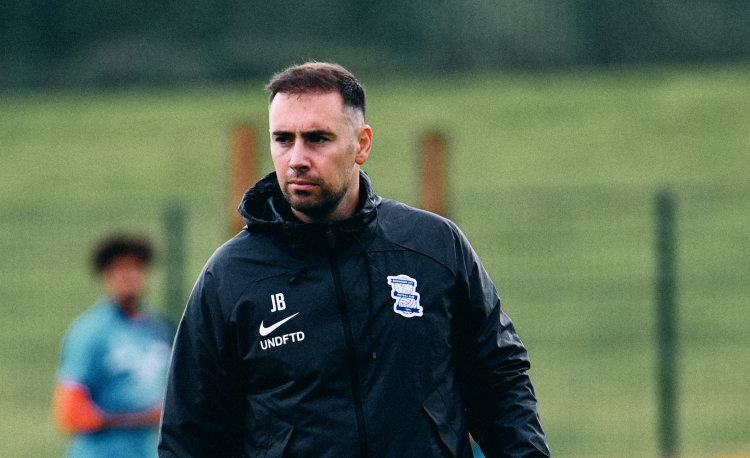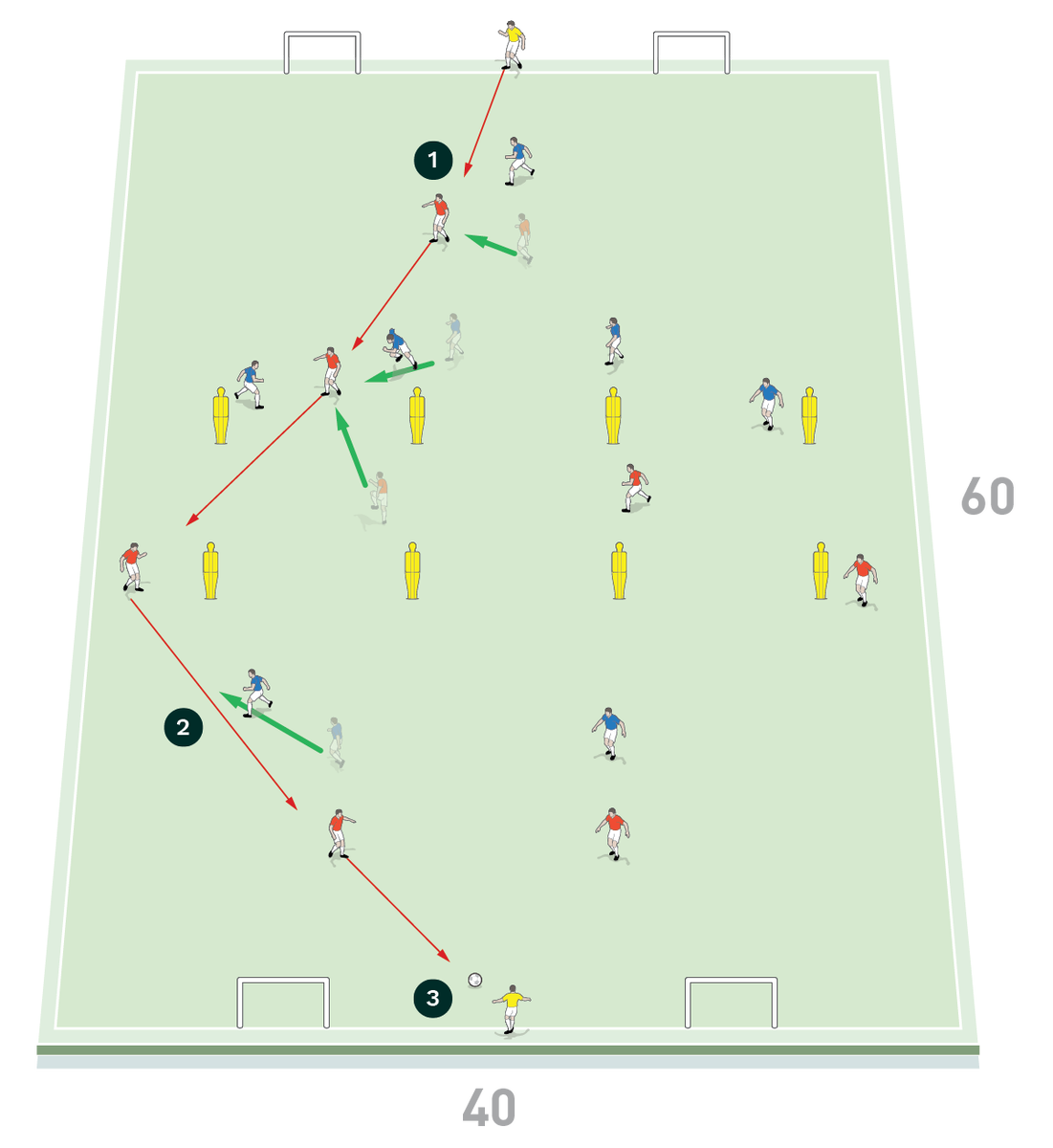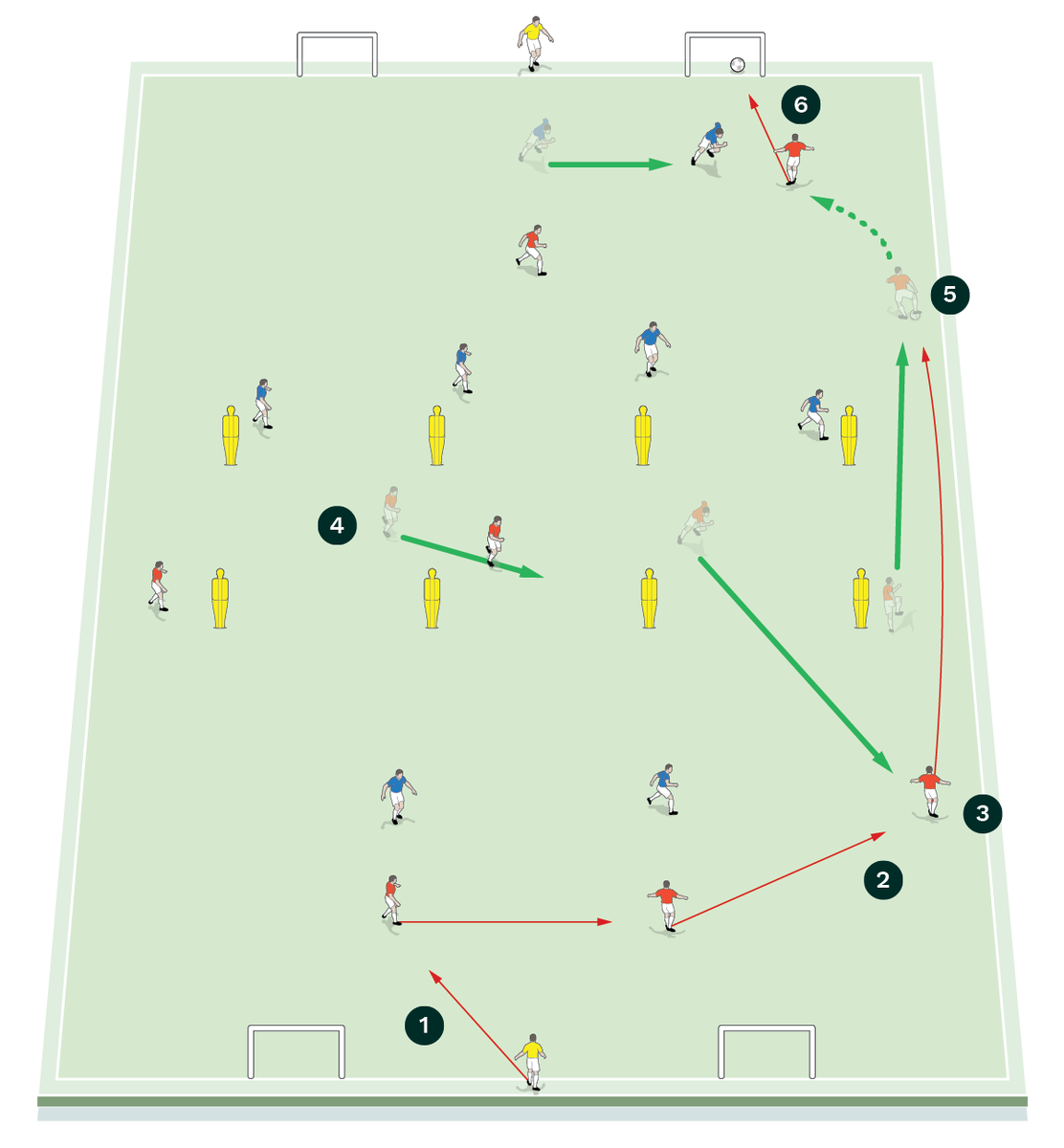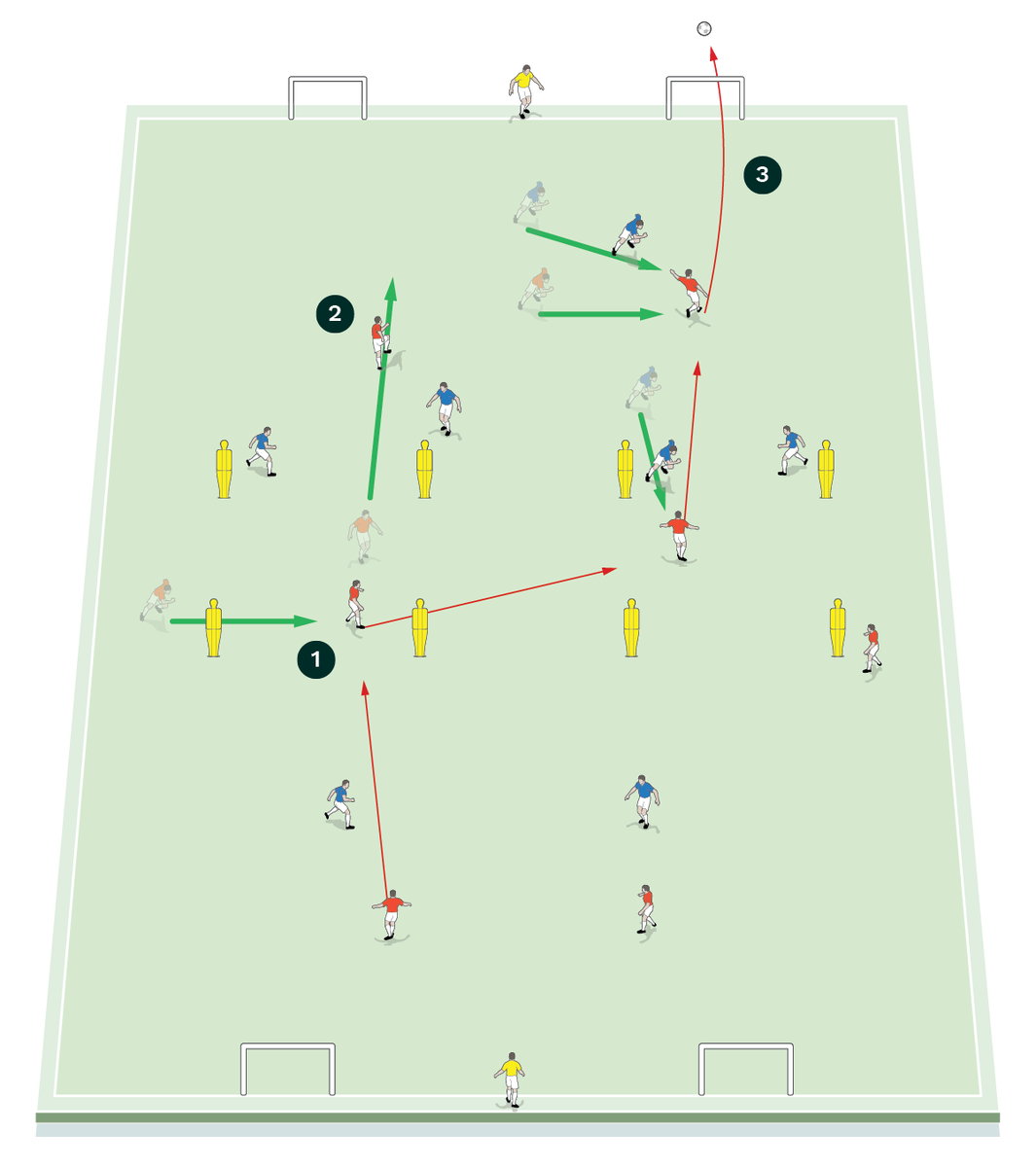Utilising the full back in build-up play
This session is designed around using our full backs in build-up play. It is split into two activities, with the first technical practice allowing for repetition of passing and receiving skills

| Area | Up to 60x40 yards |
| Equipment | Balls, bibs, cones, mannequins |
| No. of Players | Up to 16 players |
| Session Time | Passing and receiving drill: 10mins Possession game: 20mins |
This session is designed around using our full backs in build-up play. It is split into two activities, with the first technical practice allowing for repetition of passing and receiving skills. It might be primarily a technical practice, but it also has tactical outcomes, maximising its effectiveness by creating some tactical pictures for the players.
The second practice, meanwhile, is a possession based game with the creation of tactical pictures as its main focus. This allows for a steady flow between the first and second practices.
As a complete session it has a clear focus and due to its flexibility it proves engaging for central midfielders, wide players, centre backs and full backs.
We would utilise these practices in pre-season and reinforce them throughout the season when we focus on build-up play from the back.
“As a session it has a clear focus and due to its flexibility it proves engaging for central midfielders, wide players, centre backs and full backs”
PASSING AND RECEIVING DRILL
We set up a playing area of 50x50 yards. Five mannequins are set out across the area as shown. We’re using 10 outfield players: five centre backs, two full backs, a wide midfielder, a central midfielder and a number 10 and they are positioned as shown.
The practice is intended to draw out two tactical pictures. The first is a false full back, where the centre midfielder rolls out to the full back position, while the second has the left back rolling inside to receive as a central midfielder.
The players pass the ball in sequence, starting with the centre back furthest left at the bottom. The ball is played to the centre back next to them, who plays it to the next centre back. The central midfielder rolls out into the full back position, while the right back moves into the wide midfield position and the wide midfielder goes into the 10 position. The ball is passed through these players in sequence, as shown [1a].
[1a]

- The players pass the ball in sequence, starting with the centre back furthest left at the bottom. It is then passed across the back line
- The central midfielder rolls out into the right back position, receives from the centre back and plays a forward pass
- The right back moves forward into the wide midfield position to receive the forward pass, while the wide midfielder goes inside into the 10 position to receive
The number 10 plays it to the centre back at the top, who in turn plays it to the other centre back before receiving the ball back. Play continues to create the second technical picture – with the left back rolling inside to receive in the central midfield position and then plays it on to the number 10, who in turn plays the ball to the centre back furthest left at the bottom, as shown [1b].
[1b]

- The player who has moved in to the number 10 position plays it to the centre back at the top
- The centre back at the top plays it to the other centre back before receiving the ball back
- The left back rolls inside to receive as a central midfielder and then plays it on to the number 10
- The number 10 plays the ball to the centre back, who started the move and the drill repeats
“The play continues to create the second technical picture – with the left back rolling inside to receive in the central midfield position”
The sequences continues to go round again.
POSSESSION GAME
We set up a playing area of 60x40 yards with two mini goals at each end. We position eight mannequins in two blocks of four in the centre of the playing area to act as reference points for the players.
We’re using 16 outfield players split into two teams of seven plus two yellow floaters who are positioned between the goals at either end.
Play starts with a yellow floater on the ball. The yellow floater plays it out to one of the teams who are in a 7v7 and the receiving team have to keep possession while working the ball from one yellow floating player down to the other, as shown [2a].
[2a]

- Play starts with a yellow floater on the ball. The yellow floater plays it out to one of the teams who are in a 7v7
- The receiving team has to keep possession while working the ball from one yellow floating player down to the other
The possession team cannot try and score until both yellow floaters have touched the ball. As soon as they have done this the practice becomes directional and the possession team attacks one way and can score.
With the game now directional, teams are encouraged to perform one of the coached technical moves rehearsed in the previous practice. In the first example, as shown [2b].
[2b]

- Once both yellow floaters have touched the ball, the practice becomes directional and the floater plays the ball out to the team who are attacking the other end
- The reds defenders receive the ball from the floater and build an attack from the back
- The centre midfielder rolls out wide to become a false full back, while the other centre midfielder comes across to cover
- The other centre midfielder comes across to cover
- The full back moves forward into the winger position, while the centre midfielder receives the ball in the right back position and plays it forwards to the attacking full back
- The full back shoots at goal and scores
The reds create the false full back technical picture. To do this the centre back is in possession and the centre midfielder rolls out to become a false full back, while the other centre midfielder comes across to cover. The full back moves forward into the winger position, while the centre midfielder receives the ball and plays it on to the full back. The team continues the move to score a goal.
The game resets each time the ball is dead and play starts again with the ball being moved between floaters to unlock the ability to build a directional attack.
In the second example, as shown [2c].
“Here the reds are on the ball and they create the full back rolling in as a centre midfielder tactical picture”
[2c]

- The left back rolls in to become a centre midfielder and receives the ball from the centre back
- The centre midfielder moves forward into an attacking role, while the striker moves to the right creating a box shape
- The team continues the move to score a goal
The reds are on the ball and they create the full back rolling in as a centre midfielder technical picture. The centre back is in possession and the left back rolls in to become the centre midfielder. The centre midfielder moves forward into an attacking role, creating a box, while striker moves to the right. The left back, now in the middle, receives the ball from the centre back, and the team continues the move to score a goal.
In the third example, as shown [2d].
[2d]

- The centre back has the ball and both centre backs pull wide
- The centre midfielder drops creating a back three
- The left back advances up the wing and receives a long ball played by the centre back
- The left back sets up the striker for a goal scoring opportunity
The reds have possession of the ball and they create a back three tactical picture with the full backs running off and the centre midfielder dropping in.
The centre back has the ball and both centre backs pull wide. The centre midfielder then drops into the back three while the full backs advance. The centre back plays the ball long to the advancing left back and the team continues the move to score a goal.
We would run these patterns in three blocks of six minutes. However, this can be manipulated depending on the physical outcomes we want to achieve.
This practice can be progressed and manipulated by the addition of more floating players to make the practice easier; or by increasing numbers and reducing space to make the practice harder.
COACHING POINTS
What are the key things to look out for?
Players must be shown the three tactical pictures within the possession game and understand why they are playing end to end before the practice becomes directional. Following transitions the players must play from one end to the other to unlock the ability to build. This is to ensure that we have secure possession and have been able to structure the pitch so we have height, width and depth through our team’s positioning.
What are the typical mistakes players might make and how do I avoid them?
In the passing and receiving drill, it is important to focus on timing of movements, detail of passes, sets and first touches. In the possession game, players can get drawn to the ball due to its transitional starting point
Editor's Picks
Attacking transitions
Deep runs in the final third
Using the goalkeeper in build-up play
Intensive boxes drill with goals
Penetrating the final third
Creating and finishing
My philosophy
Pressing initiation
Compact team movement
Coaches' Testimonials

Alan Pardew

Arsène Wenger

Brendan Rodgers

Carlos Carvalhal

José Mourinho

Jürgen Klopp

Pep Guardiola

Roy Hodgson

Sir Alex Ferguson

Steven Gerrard
Coaches' Testimonials

Gerald Kearney, Downtown Las Vegas Soccer Club

Paul Butler, Florida, USA

Rick Shields, Springboro, USA

Tony Green, Pierrefonds Titans, Quebec, Canada
Join the world's leading coaches and managers and discover for yourself one of the best kept secrets in coaching. No other training tool on the planet is written or read by the calibre of names you’ll find in Elite Soccer.
In a recent survey 92% of subscribers said Elite Soccer makes them more confident, 89% said it makes them a more effective coach and 91% said it makes them more inspired.
Get Monthly Inspiration
All the latest techniques and approaches
Since 2010 Elite Soccer has given subscribers exclusive insight into the training ground practices of the world’s best coaches. Published in partnership with the League Managers Association we have unparalleled access to the leading lights in the English leagues, as well as a host of international managers.
Elite Soccer exclusively features sessions written by the coaches themselves. There are no observed sessions and no sessions “in the style of”, just first-hand advice delivered direct to you from the coach.









